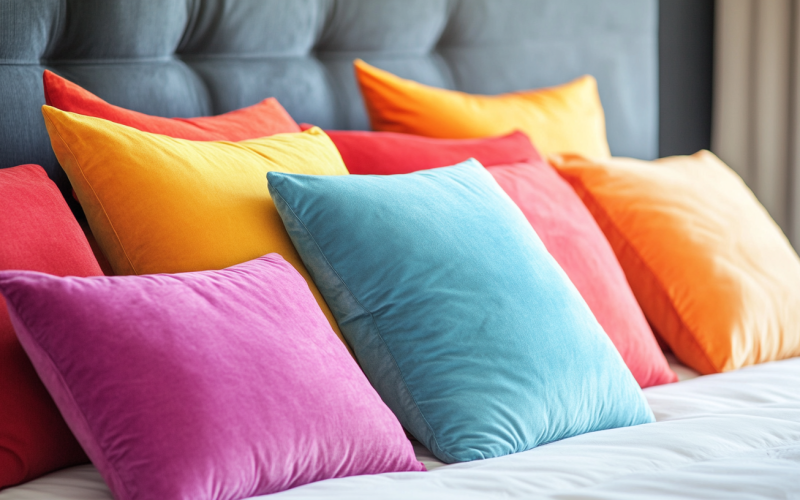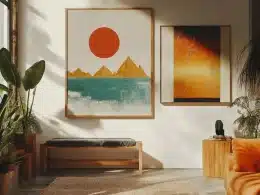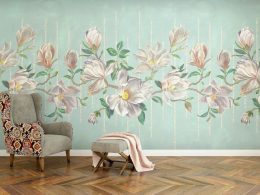Plain walls can make a room feel lifeless and dull.
Many homeowners want to add character to their spaces but aren’t sure how to do it effectively.
Wood trim accent walls offer a solution that’s both stylish and achievable.
These walls can transform any room, adding depth, texture, and visual interest without breaking the bank.
This article will showcase creative accent wall ideas using wood trim suitable for various styles and budgets.
From classic board and batten to modern geometric patterns, you’ll find inspiration to make your walls stand out.
We’ll cover different wood types, design tips, and installation techniques to help you create a stunning focal point in your home.
With these wood-trim accent wall ideas, get ready to turn your boring walls into conversation starters.
Ideas For Accent Walls With Wood Trim
1. Bold Board and Batten

Bold board and batten accent walls feature vertical wood panels separated by narrow battens.
This design originates from traditional exterior siding but has been adapted for interior use. It offers a dynamic and visually striking element to any room.
The vertical lines create a sense of height and sophistication, making it a popular choice for modern, farmhouse-style interiors.
Using boards of varying widths and heights, you can customize the look to suit your taste and your home’s architectural style.
Design Tip
- Use bold paint colors to create a dramatic effect.
- Consider deep hues like navy, charcoal, or forest green to make the wood trim stand out and add depth to the room.
- For a cohesive look, paint the trim and the wall in the same color, or opt for a high-contrast combination to make the battens pop.
Applications
- Suitable for bedrooms and living rooms.
- A bold board and batten wall can serve as a stunning headboard backdrop in bedrooms, adding texture and interest.
- In living rooms, it can highlight a fireplace or be the main feature behind a sofa, creating a focal point that draws the eye.
2. Neutral Board and Batten

Neutral board and batten accent walls provide a subtler, more refined look than their bold counterparts.
This design integrates seamlessly with the rest of the decor.
It uses soft, neutral tones, adding texture without overwhelming the space.
The simplicity of neutral colors can make a room feel more expansive and open, and the vertical lines still add a touch of elegance and sophistication.
This versatile style complements various design aesthetics, from Scandinavian minimalism to tradition.
Design Tip
- Match the trim color with the wall for a seamless look.
- Choose shades like white, beige, or light gray to keep the design understated yet elegant.
- You can also experiment with different finishes, such as matte or satin, to subtly enhance the wall’s texture and depth.
Applications
- This material is ideal for minimalist and modern interiors.
- In minimalist spaces, a neutral board-and-batten wall can add the necessary detail and texture without cluttering the visual landscape.
- Contemporary interiors can provide a clean, structured background that enhances other design elements like furniture and artwork.
3. Picture Frame Molding

Picture frame molding involves arranging wood trim to create rectangular or square frames on the wall.
This classic design technique adds a touch of elegance and architectural interest to any room.
The frames can be arranged symmetrically or asymmetrically, depending on the desired effect.
This style harks back to traditional European interiors but can be modernized with creative configurations and contemporary colors.
The frames create shadow lines and depth, making the wall visually engaging and sophisticated.
Design Tip
- Highlight with contrasting wall colors inside the frames.
- If the molding is white, consider painting the interior of the frames a bold or dark color to make the design stand out.
- Alternatively, wallpaper inside the frames can add pattern and interest, creating a unique feature wall.
Applications
- Picture frame molding is best for living rooms and hallways.
- It elevates the overall decor in living rooms, creating a backdrop for artwork or mirrors.
- It adds detail and breaks up long wall stretches in hallways, making the space feel more refined and finished.
4. Framed Wallpaper Panels

Combining wood trim with wallpaper inserts, framed wallpaper panels offer a creative way to incorporate color and pattern into your space.
The wood trim acts as a border, framing sections of wallpaper to create a paneled effect.
This design allows for using bold and intricate wallpapers without overwhelming the room, as the wood trim provides a visual break.
It’s a versatile technique that can be adapted to fit various styles, from traditional to eclectic.
Design Tip
- Use vibrant wallpaper for a pop of color and texture.
- Select patterns that complement the room’s color scheme and overall aesthetic.
- For a cohesive look, coordinate the wallpaper colors with the surrounding decor.
Applications
- Framed wallpaper panels are great for bedrooms and dining rooms.
- In bedrooms, they can serve as an elegant headboard alternative.
- In dining rooms, they add sophistication and visual interest, making the space more formal and inviting.
5. Fluted Feature

A fluted wood trim accent wall features vertical grooves or ridges, adding a modern and sleek element to the room.
This style is inspired by classical architecture but has been reinterpreted for contemporary interiors.
The fluted design creates subtle shadows and highlights, adding texture and depth to the wall.
It’s a minimalist yet striking feature that can enhance the overall aesthetic of any space.
Design Tip
- Use light wood tones for a Japandi-style interior.
- The natural wood finish complements the minimalist and serene aesthetic of Japandi design.
- Consider darker wood stains or painted finishes highlighting the fluted texture for a more dramatic look.
Applications
- Fluted feature walls are suitable for living rooms and feature walls.
- In living rooms, they can serve as a sophisticated backdrop for seating areas or entertainment centers.
- In entryways or hallways, they create a welcoming and stylish first impression.
6. Paneling with Beadboard

Beadboard paneling involves narrow vertical wood planks with a distinctive ridge or “bead” between each plank.
This design adds texture and a subtle decorative element to the walls.
Beadboard can be used as wainscoting or cover an entire wall, bringing a charming, cottage-like feel.
The vertical lines of beadboard can also help make a room appear taller and more spacious.
Design Tip
- Paint beadboard in soft pastels or crisp whites for a classic look.
- Consider using bold colors or a glossy finish for a more modern twist to make the texture stand out.
- Ensure the edges are neatly trimmed to maintain a polished appearance.
Applications
- Beadboard is ideal for bathrooms and kitchens.
- It provides a traditional yet fresh look in bathrooms and is often used to protect walls from moisture.
- It adds a touch of vintage charm in kitchens, particularly as a backsplash or accent wall behind cabinetry.
7. Raised Geometric Design

Raised geometric designs using wood trim create a bold and dynamic feature wall.
By arranging thin wood strips in geometric patterns, such as triangles, diamonds, or hexagons, you can add a modern and artistic touch to any room.
The raised elements create shadows and depth, making the wall a focal point.
This design is perfect for those who want to make a statement with their decor.
Design Tip
- Choose a single wall to avoid overwhelming the space.
- Use complementary colors for the trim and background to enhance the geometric patterns.
- Consider incorporating lighting to accentuate the raised design and create dramatic effects.
Applications
- Perfect for nurseries and children’s rooms.
- In nurseries, the playful patterns can stimulate visual interest and creativity.
- In children’s rooms, it adds a fun and vibrant element that grows with the child, making the room feel dynamic and engaging.
8. Rustic Reclaimed Wood

Using reclaimed wood for a rustic accent wall brings a sense of history and character to any room.
The unique textures, colors, and imperfections of reclaimed wood create a one-of-a-kind feature that adds warmth and authenticity.
Whether sourced from old barns, factories, or other structures, reclaimed wood tells a story and adds a rustic charm that is hard to replicate with new materials.
Design Tip
- Mix different shades and textures for an authentic look.
- Use a combination of wide and narrow planks, and vary the lengths to create a visually interesting pattern.
- Consider sealing the wood to protect it and enhance its natural beauty.
Applications
- Reclaimed wood accent walls are suitable for living rooms and entryways.
- In living rooms, they can serve as a cozy backdrop for seating areas, adding a touch of rustic elegance.
- In entryways, they create a welcoming and unique first impression, setting the tone for the rest of the home.
9. Vertical Shiplap

Installing shiplap boards vertically is a modern twist on a traditional design.
Vertical shiplap creates clean lines and a sense of height, making rooms appear taller and more spacious.
This versatile design fits well with various styles, from modern to farmhouse.
The overlapping edges of shiplap boards add subtle texture and depth, enhancing the visual appeal of the wall.
Design Tip
- Use this design to make ceilings appear higher.
- Choose light colors like white or soft pastels to enhance the space’s airy feel.
- Consider darker hues that add a modern edge to the traditional shiplap look for a more dramatic effect.
Applications
- Vertical shiplap is best for modern and farmhouse styles.
- In modern interiors, it provides a sleek backdrop.
- In farmhouse settings, it adds a rustic charm that complements the cozy, homey atmosphere.
10. Horizontal Shiplap
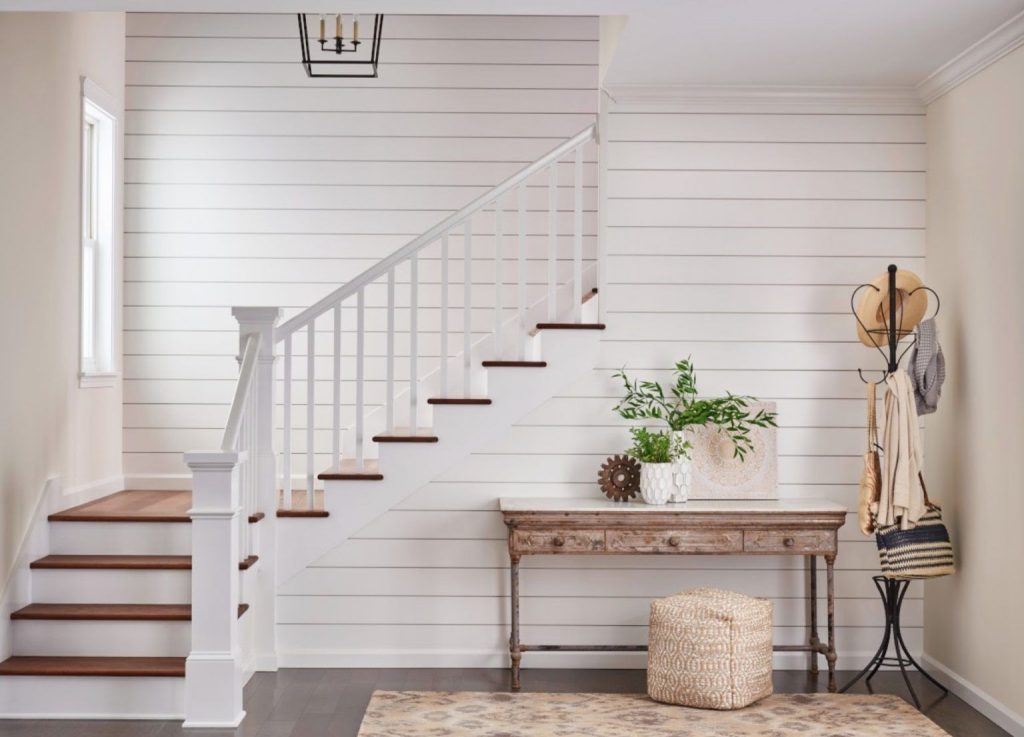
Traditional horizontal shiplap boards are a timeless choice for accent walls.
This design is characterized by wide wooden planks installed horizontally, creating a classic, coastal-inspired look.
The clean, linear lines of horizontal shiplap add structure and a sense of calm to any room.
It’s a versatile design that works well in various settings, from beach houses to modern urban homes.
Design Tip
- Paint in light colors to enhance coastal vibes.
- White or light blue shiplap can create a serene and relaxing atmosphere.
- To make a striking statement, experiment with bold colors or even black shiplap for a more contemporary look.
- Ensure the finish is smooth and even to maintain the clean lines that characterize shiplap.
Applications
- Horizontal shiplap is ideal for beach houses and coastal interiors.
- It accentuates beach houses’ relaxed, nautical feel, making spaces like living rooms and bedrooms airy and bright.
- It adds a timeless charm to coastal interiors, enhancing the overall aesthetic and making the space feel like a seaside retreat.
11. Natural Horizontal Planks

Horizontal wood planks in natural finishes bring any room a warm, earthy touch.
This design emphasizes the beauty of the wood grain and natural imperfections, creating a rustic yet sophisticated look.
The planks add texture and warmth by keeping the wood in its natural state or with a light stain, making the room feel cozy and inviting.
The horizontal layout helps elongate the room, adding a sense of space.
Design Tip
- Maintain the wood’s natural grain for an earthy feel.
- Use a clear sealant to protect the wood and enhance its natural color.
- Mix different widths and lengths of planks for added depth, and consider a staggered installation pattern to create visual interest.
Applications
- Natural horizontal planks are suitable for living rooms and bedrooms.
- In living rooms, they can create a rustic focal point behind a sofa or fireplace.
- They add a touch of warmth and coziness to bedrooms, making the space feel like a serene retreat.
12. Flush Geometric Design

Creating geometric patterns with flush wood trim involves arranging wood pieces in flat, seamless designs that add a modern and artistic touch to any room.
This technique can include shapes such as squares, rectangles, hexagons, or even custom patterns, providing a sleek and contemporary look.
The flush installation creates clean lines and a smooth surface, making the wall an understated yet striking feature.
Design Tip
- Keep the design simple for a modern look.
- Choose monochromatic or complementary color schemes to maintain a cohesive aesthetic.
- Use high-quality wood with a fine grain and a smooth finish for added sophistication.
Applications
- Flush geometric designs are best for contemporary and minimalist interiors.
- They provide a subtle yet impactful feature in contemporary spaces that complements modern furniture and decor.
- In minimalist interiors, the clean lines and simple shapes enhance the overall aesthetic without adding visual clutter.
13. Vertical Wood Trim on a Black Wall
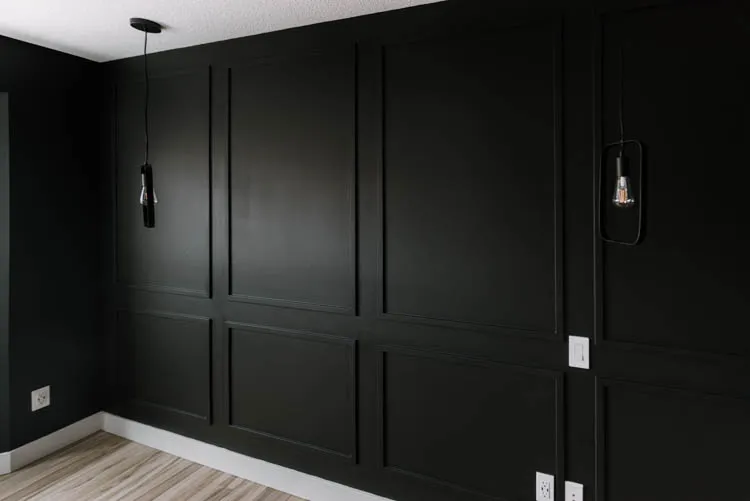
Vertical wood trim on a painted black wall creates a dramatic, sophisticated look.
The contrast between the dark background and the natural wood trim adds depth and visual interest, making the wall a focal point.
This design is particularly effective in modern and industrial interiors, where the stark contrast and clean lines contribute to a bold and stylish aesthetic.
Design Tip
- Use contrasting wood stains for added depth.
- Darker stains can create a sleek, cohesive look, while lighter stains provide a striking contrast against the black background.
- Ensure the trim pieces are evenly spaced and perfectly vertical to maintain the design’s clean and polished appearance.
Applications
- Ideal for modern and industrial interiors.
- In modern homes, vertical wood trim on a black wall can be a stunning backdrop for artwork or furniture.
- In industrial spaces, it adds a touch of warmth and texture, balancing the decor’s raw, edgy elements.
14. Half Wall Molding

Chair rail molding creates a half-wall effect, also known as wainscoting, and adds a classic and elegant touch to any room.
This design involves installing molding at chair height around the perimeter of the room, often with panels or additional trim below the rail.
The result is a sophisticated, layered look that adds depth and architectural interest.
This versatile style can suit various design aesthetics, from traditional to contemporary.
Design Tip
- Paint the lower half in a darker shade for contrast.
- Choose colors that complement the upper wall and the rest of the decor.
- For a traditional look, use rich, warm colors; for a modern twist, opt for cool, neutral tones.
- Add decorative panels or beadboard below the chair rail for texture and interest.
Applications
- Half-wall molding is suitable for dining rooms and hallways.
- It adds a formal touch to dining rooms, enhancing the overall elegance.
- In hallways, it protects the walls from scuffs and adds visual interest, making the area feel more finished and refined.
15. Black Shiplap

Shiplap boards painted black offer a bold and contemporary take on a classic design.
This modern approach to shiplap creates a striking, dramatic effect that can transform any room.
The horizontal lines of the shiplap add structure, while the black color adds depth and sophistication.
This design is perfect for creating a feature wall that stands out and makes a statement.
Design Tip
- Use in entryways for a bold first impression.
- Pair the black shiplap with contrasting light or neutral furniture and decor to balance the dark wall.
- Add metallic accents, such as brass or gold fixtures, to enhance the luxurious feel of the space.
Applications
- Black shiplap is great for entryways and statement walls.
- In entryways, it creates a dramatic and welcoming first impression, setting the tone for the rest of the home.
- As a statement wall in living rooms or bedrooms, it adds a modern, sophisticated touch that draws the eye and anchors the room.
16. Chevron Pattern
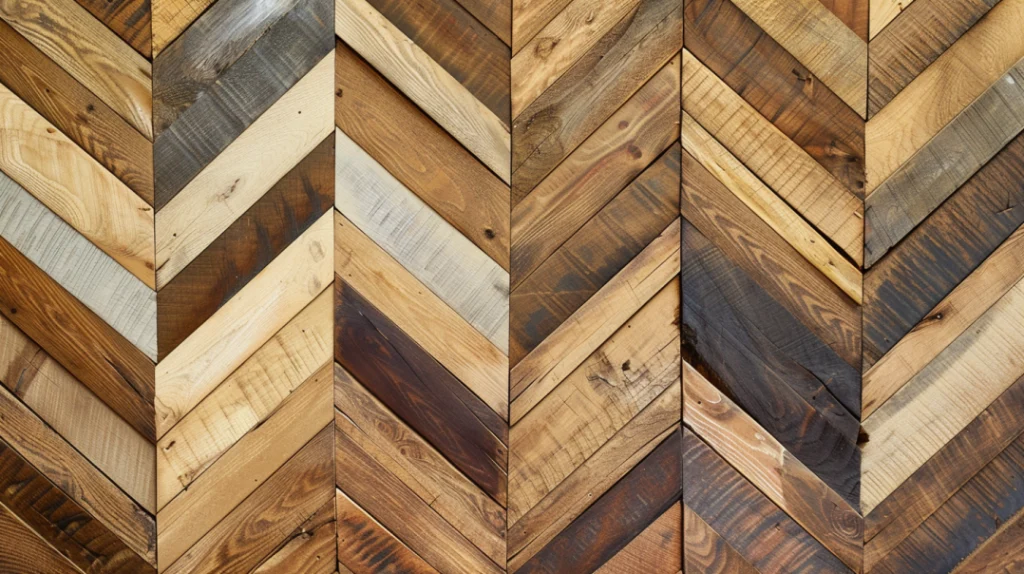
The Chevron pattern is a timeless and elegant design choice for wood-trim accent walls.
Arranging wood planks in a V-shaped pattern creates a visually striking focal point that adds depth and dimension to the room.
Depending on the materials and finishes used, this design can be adapted to fit various styles, from classic to contemporary.
The repetitive nature of the Chevron pattern creates a sense of movement, making the wall dynamic and engaging.
Design Tip
- Use natural wood or bold colors for impact.
- Natural wood finishes add warmth and a rustic touch, while bold colors like deep blue or emerald green can create a modern, vibrant look.
- To maintain the integrity of the pattern, ensure precise alignment and consistent spacing.
Applications
- Chevron-patterned accent walls are perfect for feature walls in living rooms.
- They can serve as a dramatic backdrop for a seating area or entertainment center, adding a touch of elegance and sophistication and making the space feel more designed and intentional.
17. Geometric Design

Geometric designs using wood trim offer endless possibilities for creating unique, eye-catching accent walls.
From simple shapes like squares and rectangles to more complex patterns like hexagons and triangles, geometric designs add a modern and artistic touch to any room.
These patterns can be created with varying depths and textures, adding visual interest and depth.
The clean lines and structured layout make geometric designs versatile for contemporary interiors.
Design Tip
- Experiment with different patterns for a custom look.
- Mix and match shapes and sizes to create a design that reflects your style.
- Use contrasting colors or finishes to highlight the geometric shapes and add visual interest.
- Consider incorporating lighting to enhance the depth and texture of the design.
Applications
- Geometric designs are suitable for modern and eclectic interiors.
- In modern spaces, they provide a sleek and structured backdrop that complements minimalist furniture and decor.
- In eclectic interiors, they add a playful and artistic element that enhances the overall aesthetic.
18. Mixed Materials

Combining wood trim with other materials such as metal, stone, or tile creates a visually dynamic accent wall.
This design approach adds texture and interest by juxtaposing different materials, creating a unique and sophisticated look.
Whether pairing rustic wood with sleek metal or combining textured stone with smooth wood trim, the possibilities are endless.
The contrast between materials adds depth and complexity, making the wall a standout feature in any room.
Design Tip
- Ensure a cohesive look with complementary materials.
- Choose materials that work well together and fit the overall design aesthetic of the room.
- Use consistent colors or finishes to tie the different elements together.
- Consider the scale and proportion of each material to maintain balance and harmony.
Applications
- Mixed-material accent walls are ideal for living rooms and kitchens.
- In living rooms, they can serve as a dramatic focal point behind a sofa or entertainment center.
- In kitchens, they add a touch of luxury and sophistication, creating a unique backdrop for cooking and entertaining.
19. Painted Wood Trim

Painted wood trim offers a bold and customizable option for accent walls.
By painting the wood trim in vibrant or pastel colors, you can add personality and charm to the space.
This technique allows for endless customization, making it easy to match the trim with the room’s color scheme and overall design.
Painted wood trim can highlight architectural details, create patterns, or add color to a neutral wall.
Design Tip
- Match or contrast with wall colors for the desired effect.
- For a cohesive look, paint the trim in a color that complements the wall.
- Use contrasting colors to make the trim stand out for a dramatic effect.
- Consider using high-gloss or metallic paint for added shine and sophistication.
Applications
- Great for children’s rooms and playful interiors.
- In children’s rooms, painted wood trim adds a fun and whimsical touch, making the space vibrant and engaging.
- Playful interiors enhance the overall aesthetic, adding color and interest without overwhelming the room.
20. Stacked Wood Planks

Vertically stacked narrow wood planks create a sleek and contemporary look for accent walls.
This design involves stacking thin wood strips with minimal spacing between each plank, creating a clean and minimalist aesthetic.
The vertical arrangement adds height and structure to the room, making it more spacious and open.
Stacked wood planks are versatile and work well in various settings, from modern to Scandinavian-inspired interiors.
Design Tip
- Use minimal spacing for a sleek look.
- Choose wood with a fine grain and smooth finish to enhance the design’s clean lines.
- Consider using a clear sealant or light stain to highlight the wood’s natural beauty.
- For a more modern look, paint the planks in a uniform color.
Applications
- They are best for minimalist and Scandinavian designs.
- In minimalist spaces, stacked wood planks provide a subtle yet impactful feature that enhances the overall aesthetic.
- Scandinavian interiors add warmth and texture, complementing the simple and functional design.
21. Picture Frame Effect

Thin wood trim creates picture frames on the wall, adding a classic and elegant touch to any room.
This design involves installing narrow strips of wood to create rectangular or square frames, which can be painted or left natural.
The picture frame effect adds depth and architectural interest, making the wall a focal point.
This versatile style can be adapted to fit various design aesthetics, from traditional to contemporary.
Design Tip
- Paint the insides of frames for added contrast.
- Use bold or contrasting colors inside the frames to make the design stand out.
- Choose complementary colors that enhance the overall aesthetic for a more subtle look.
- Consider using wallpaper inside the frames for added texture and interest.
Applications
- Picture frame molding is suitable for living rooms and feature walls.
- In living rooms, it adds sophistication and elegance, creating a refined backdrop for artwork or mirrors.
- Feature walls add interest and depth, making the space feel more designed and intentional.
Conclusion
Wood trim accent walls offer a world of possibilities to transform your living spaces.
These ideas suit any style and budget, from classic board and batten to modern geometric designs.
You can create a stunning focal point in your home by choosing the right wood, planning your design, and considering professional help for complex patterns.
Remember, an accent wall isn’t just about looks – it’s about adding character and warmth to your space.
Whether you’re a DIY enthusiast or prefer professional installation, these wood trim ideas can help you make a big impact with relatively little effort.
Ready to give your walls a makeover?
Select your favorite design from our list and envision how it could enhance your room.
Don’t be afraid to get creative – your perfect accent wall is just a project away!






